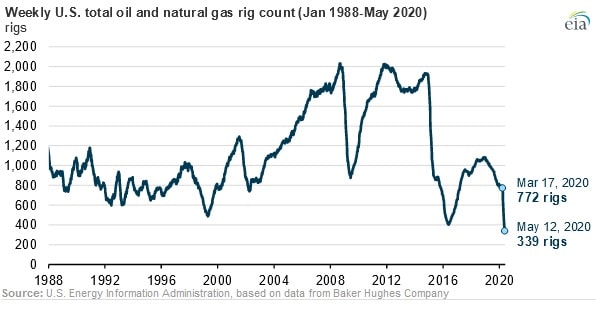U.S. Active Crude Oil, Natural Gas Rigs Hit Record Low: EIA

U.S. active crude oil and natural gas rigs dropped to their lowest number in over three decades, according to a May 20 report from the U.S. Energy Information Administration. The number of rigs declined sharply to 339 on May 12, a 56 percent decline since March 17, due to an unprecedented drop in petroleum demand and prices resulting from mitigation efforts put in place to curb the spread of COVID-19.
Natural gas-focused rigs had significant losses, but oil-focused rigs suffered the biggest impact. The top three U.S. crude oil producing regions were the most affected by the downturn, with the Permian region in southeastern New Mexico and western Texas deactivating 57 percent of their total amount of rigs. The Eagle Ford region in southern Texas and the Bakken region in Montana and North Dakota saw their oil-rig counts decline by 64 percent and 69 percent, respectively. The two main natural gas producing regions also experienced considerable losses, with rig counts in the Marcellus and Haynesville regions falling by 23 and 26 percent, respectively. The Permian region is also a substantial producer of natural gas, however all rigs in the area are classified as oil-directed.
Fluctuations in oil prices have historically influenced the number of active oil rigs, usually with a lag of about four months, but the current drop occurred on a much shorter timespan. The spot price of West Texas Intermediate was $46.78 per barrel at the beginning of March, but dropped to $20.51 per barrel at the end of the month.
Natural gas prices and active rig numbers have a similar behavior to crude oil, but prices in early 2020 were already at multi-year lows due to a record high production in late 2019, a low demand caused by warmer weather and somewhat modest withdrawals from storage during the winter season.
EnerKnol Pulses like this one are powered by the EnerKnol Platform—the first comprehensive database for real-time energy policy tracking. Sign up for a free trial below for access to key regulatory data and deep industry insights across the energy spectrum.
ACCESS FREE TRIAL